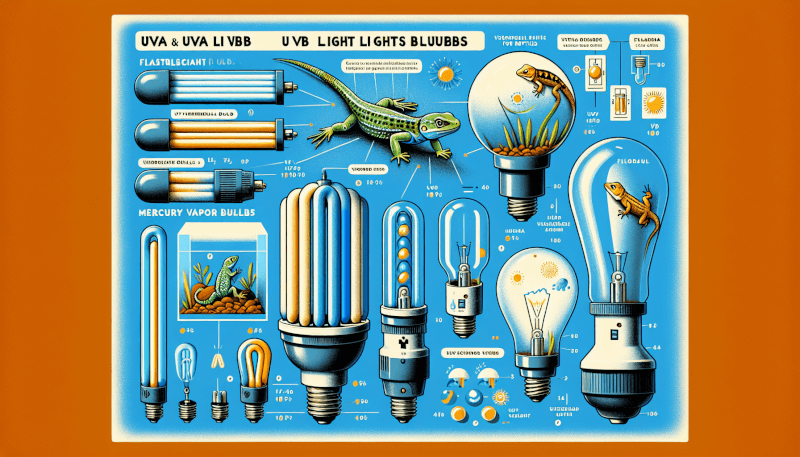Imagine you and your new reptile buddy basking under the warm glow of a UVA and UVB bulb, soaking up the healthy benefits. But before you can create this cozy scenario, you need to make sure you choose the right bulbs for your scaly companion. With so many options available, it can be a bit overwhelming. That’s why we’re here to lend a helping hand and guide you through the ins and outs of selecting the perfect UVA and UVB bulbs for your pet reptile. Get ready to brighten your reptile’s life with the right bulbs!
Benefits of UVA and UVB Bulbs for Reptiles
Reptiles, like any other living creatures, require specific lighting conditions to maintain their health and overall well-being. UVA and UVB bulbs play a crucial role in providing reptiles with the necessary ultraviolet (UV) light they need. These bulbs serve as a vital source of sunlight for reptiles in captivity, mimicking the natural lighting conditions they would experience in their natural habitats.
Why reptiles need UVA and UVB light
UVA and UVB light are essential for reptiles as they provide numerous benefits. UVA light helps reptiles in various ways, including promoting natural behaviors such as feeding, mating, and basking. This form of light also enhances the reptiles’ visual perception and helps regulate their circadian rhythm.
On the other hand, UVB light ensures the reptiles receive the necessary amount of Vitamin D3, which is vital for calcium absorption and bone health. Without proper UVB exposure, reptiles can develop metabolic bone disease, resulting in weakened bones, deformities, and, in severe cases, even death.
The importance of UVA and UVB light for reptile health
UVA and UVB light are crucial for maintaining a reptile’s overall health and well-being. These lights are essential for the proper functioning of their immune system, the development of strong bones and shells, and the regulation of their metabolism. Without adequate exposure to UVA and UVB light, reptiles may become lethargic, lose their appetite, and suffer from various health issues, leading to a decreased quality of life.
Understanding UVA and UVB Light
Difference between UVA and UVB light
UVA and UVB light are both forms of ultraviolet radiation, but they have distinct differences and purposes. UVA light consists of longer wavelengths and is responsible for behaviors, such as basking and feeding, in reptiles. UVB light, on the other hand, has shorter wavelengths and is primarily responsible for the synthesis of vitamin D3 in reptiles.
Recommended levels of UVA and UVB light for reptiles
To ensure the well-being of your reptile, it is crucial to provide the appropriate levels of UVA and UVB light. The recommended UV index levels for reptiles vary depending on the species. In general, the UV index should fall within the range of 2-5 for diurnal reptiles (active during the day) and 0-0.5 for nocturnal reptiles (active during the night). It is essential to research your specific reptile species to determine its UV index requirements accurately.
Factors to Consider Before Purchasing Reptile UVA and UVB Bulbs
Before purchasing UVA and UVB bulbs for your reptile enclosure, several factors need to be considered to ensure you provide the best lighting setup for your pet.
Species-specific requirements
Different reptile species have varying lighting requirements, depending on their natural habitat and behaviors. It is crucial to research and understand the specific lighting needs of your reptile species before selecting UVA and UVB bulbs. This will ensure you provide the most suitable lighting conditions to replicate their natural environment.
Size and setup of the enclosure
The size and setup of your reptile’s enclosure play a crucial role in determining the type and wattage of the UVA and UVB bulbs required. Larger enclosures may require higher wattage bulbs or multiple bulbs to provide adequate coverage throughout the space. Consider the dimensions of the enclosure and the reptile’s basking area when selecting bulbs.
Age and health condition of the reptile
Younger reptiles and those with specific health conditions may have different lighting requirements compared to adult and healthy reptiles. Consult with a veterinarian or reptile specialist to determine if any special considerations need to be taken into account when selecting UVA and UVB bulbs for your pet.
Availability of natural sunlight
If your reptile enclosure is situated in an area that receives ample natural sunlight, it may reduce the reliance on artificial UVA and UVB bulbs. However, it is still crucial to ensure that the natural sunlight is appropriate and consistent, as variations in weather and seasons may affect the availability of sufficient UV rays. Supplementing with artificial UVA and UVB bulbs is often recommended to maintain consistent lighting conditions.
Types of Reptile UVA and UVB Bulbs
Various types of UVA and UVB bulbs are available on the market, each with its own advantages and considerations. Understanding the different types will help you make an informed decision when selecting the most suitable bulbs for your reptile’s enclosure.
Fluorescent UVB bulbs
Fluorescent UVB bulbs are a popular choice among reptile owners due to their efficiency, affordability, and longevity. These bulbs emit a broad spectrum of UVB light, closely resembling natural sunlight. They are available in different lengths and are suitable for various enclosure sizes. However, it is essential to consider the bulb’s age, as UVB emission decreases over time, requiring regular replacement.
Mercury vapor bulbs
Mercury vapor bulbs are another popular option, as they provide both UVA and UVB light in one bulb. These bulbs emit a high level of UVB light, making them suitable for environments with a greater distance between the reptile and the bulb. However, they can generate more heat than fluorescent bulbs, so proper temperature regulation within the enclosure is essential.
Metal halide bulbs
Metal halide bulbs are often used for larger enclosures or reptiles with specific lighting requirements. They emit a high level of UVB light and produce bright and visually appealing lighting. However, they also generate a significant amount of heat, requiring careful temperature regulation. Additionally, metal halide bulbs are generally more expensive and consume more energy compared to other types.
LED UVB bulbs
LED UVB bulbs are a relatively new addition to the market and offer excellent energy efficiency and longevity. These bulbs emit a narrow spectrum of UVB light, making them suitable for specific reptile species with precise lighting requirements. However, LED UVB bulbs can be more expensive initially, and there may be limited options available for certain reptile species.

Choosing the Correct Wattage
Selecting the appropriate wattage for your UVA and UVB bulbs depends on various factors, including the size of the enclosure and the specific reptile species.
Factors influencing wattage selection
The size of the reptile enclosure is a significant determining factor for the wattage of the UVA and UVB bulbs. Larger enclosures require higher wattage bulbs or a greater number of bulbs to ensure adequate coverage throughout the space. Additionally, the distance between the reptile and the basking area should be considered, as this will affect the intensity of the light received.
The specific reptile species will also influence the wattage selection. Some reptiles require higher levels of UVB exposure, while others may have more modest requirements. Research the UV index recommendations for your reptile species to determine the appropriate wattage level.
Recommended wattage based on enclosure size and reptile species
As a general guideline, for reptile enclosures up to 12 inches in height, a 5-7% UVB bulb with a wattage of 15-20 watts may be sufficient. For taller enclosures, 12-24 inches in height, a 10-12% UVB bulb with a wattage of 26-40 watts may be required. However, it is crucial to research the specific lighting requirements of your reptile species and consult with a veterinarian or reptile specialist for accurate wattage recommendations.
Understanding the UV Index
What is the UV Index
The UV Index measures the intensity of UV radiation present in sunlight. It provides a scale to determine the potential harm caused by UV exposure. For reptiles, the UV Index is crucial in creating proper lighting conditions that simulate their natural habitat.
Ideal UV Index range for different reptile species
Different reptile species may have varying UV Index requirements. Generally, diurnal reptiles (active during the day) require a UV Index within the range of 2-5, while nocturnal reptiles (active during the night) require a UV Index between 0-0.5. It is essential to research the specific UV Index recommendations for your reptile species to ensure you provide the appropriate lighting conditions.

Quality and Brand Reliability
Researching reputable brands
When purchasing UVA and UVB bulbs for your reptile, it is crucial to choose products from reputable brands. Look for brands that specialize in reptile lighting and have a history of providing reliable and high-quality products. Reading reviews and seeking recommendations from experienced reptile owners or professionals can help you narrow down your options.
Considering customer reviews and recommendations
Customer reviews and recommendations can provide valuable insights into the effectiveness and reliability of UVA and UVB bulbs from specific brands. Take the time to read reviews and seek recommendations from trusted sources to ensure you make an informed decision. Pay attention to feedback regarding bulb longevity, wavelength accuracy, and overall customer satisfaction.
Budget Considerations
When purchasing UVA and UVB bulbs for your reptile, it is essential to find the right balance between cost and quality. While it may be tempting to opt for cheaper options, investing in high-quality bulbs from reputable brands can ensure the longevity and effectiveness of the lighting setup, ultimately benefiting your reptile in the long run. Consider your budget and prioritize quality when making your purchasing decision.

Installation and Placement
Proper positioning of UVA and UVB bulbs
The placement of UVA and UVB bulbs within the reptile enclosure is crucial for providing adequate exposure to the reptile. Position the bulbs in a way that covers the reptile’s basking area and allows them to bask directly under the bulbs. Ensure that there are no obstructions blocking the light, such as branches or decorations.
Accounting for distance and temperature gradients
Consider the distance between the reptile and the UVA and UVB bulbs when positioning them. Different reptile species may require varying distances to achieve the optimal light intensity and temperature. Consult with a veterinarian or reptile specialist to determine the appropriate distance and temperature gradients required for your specific reptile species.
Maintenance and Replacement
Regular cleaning and inspection
To ensure the longevity and effectiveness of your UVA and UVB bulbs, regular cleaning and inspection are necessary. Dust and debris can accumulate on the bulbs, reducing their effectiveness over time. Gently clean the bulbs according to the manufacturer’s recommendations to maintain their efficiency. Additionally, inspect the bulbs regularly for signs of damage or deterioration.
When and how to replace UVA and UVB bulbs
UVA and UVB bulbs have a limited lifespan and will gradually decrease in effectiveness over time. It is generally recommended to replace UVA bulbs every 6-12 months and UVB bulbs every 9-12 months, depending on the specific brand and type. Monitor the bulbs closely for any signs of diminished light output or when their specified lifespan is reached. Replace the bulbs promptly to ensure your reptile receives the necessary UV light for their health and well-being.
By understanding the importance of UVA and UVB bulbs for reptiles, considering various factors before purchasing, selecting the appropriate wattage and type, and properly installing and maintaining the bulbs, you can provide your beloved reptile with the optimal lighting conditions to thrive in captivity. Remember to prioritize quality, research reputable brands, and consult with professionals to ensure you make the best choices for your reptile’s health and well-being.


